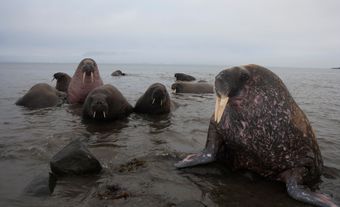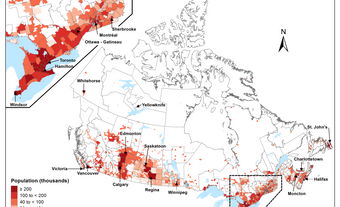The Atlantic Ocean is the world’s second-largest ocean, covering 20 per cent of the planet’s surface. It forms Canada’s eastern seaboard and includes the entire coasts of New Brunswick,
Nova Scotia, Prince Edward Island and
Newfoundland and Labrador. It also includes Quebec’s southeastern border, along the Gulf of St. Lawrence. The total length of Canada’s Atlantic coastline is approximately 42,000 km.

Human Geography
The Mi'kmaq, Wolastoqiyik, Passamaquoddy, Innu and Inuit traditionally made their homes along the coasts of the Atlantic Ocean and they continue to do so today. In addition, the Beothuk once lived on the island of Newfoundland. For all these peoples, the waters and coastline of the Atlantic Ocean provided sustenance through hunting, fishing, and harvesting a variety of wild foods. Today, many of these pursuits remain integral to Indigenous culture and livelihood.
Canada’s Atlantic coast was the first part of the country to be explored and colonized by Europeans. As with other parts of Canada, modern settler culture in the Atlantic region is influenced by people from all over the world. Certain cultural influences, namely Celtic, Acadian and African-Canadian ones, are particularly prominent.
Approximately 3 million Canadians live in Canada’s Atlantic region. Major ports include Halifax, Saint John, St. John’s and Sept-Îles. Halifax, with a depth of 18 m at low tide, is one of the world’s deepest natural harbours.
Physical Geography
Geographers divide Canada’s Atlantic Ocean into three bioregions: the Newfoundland and Labrador Shelves, the Scotian Shelf, and the Estuary and Gulf of St. Lawrence. The boundaries between them overlap and are not defined borders. The bioregions are designated based on differences in ocean depth and conditions. The Newfoundland and Labrador Shelves, for example, include the Grand Banks shelf, located southeast of Newfoundland. It covers an area of 93,200 km2 and is relatively shallow. The Grand Banks are among the most productive marine areas in the world.

The Atlantic Ocean’s coastal ecosystems include sandy beaches, rocky shores, mudflats, salt marshes, pebble beaches, fjords, bogs, islands and cliffs. Each of these ecosystems overlap. They were shaped by geology, the plants and animals that live there, as well as by ocean winds, waves, salt and currents.
The Atlantic Ocean watershed in Canada spans 1.6 million km2. Major watersheds within its boundaries include the Great Lakes–St. Lawrence River Basin, the Churchill River in Labrador and the Saint John River in New Brunswick.
In addition to Newfoundland and Prince Edward Island, Canada’s Atlantic Ocean is home to numerous, smaller islands including Cape Breton, Anticosti, Sable and Bell. Cape Breton Island's Bras d'Or Lake system, a salt-water inland lake at the centre of the island, is connected to the Atlantic by a number of channels.
Wildlife
Canada’s Atlantic Ocean floor is rich with invertebrates, such as barnacles, sea stars, crabs, lobsters, sponges, scallops, clams and jellyfish.
Common fish populations historically included northern cod redfish, and herring. Due to chronic overfishing by Canada and other nations, commercial harvests of many species are no longer sustainable.

Northern bottlenose whales swim in The Gully, off the shores of Nova Scotia. This population of northern bottlenose whales, known as the Scotian shelf population, is endangered.
("Northern bottlenose whales spyhopping" by Hilary Moors is licensed under
CC BY-NC-SA 4.0.)
Marine mammals include harbour and grey seals, as well as several species of whale. These whales are either indigenous to or migrate through the region, and include the northern bottlenose, blue, pilot, beluga, fin, minke and humpback.
Burrowing crustaceans are found in the low-lying beaches, salt marshes and tidal flats of the upper Bay of Fundy and the southern Gulf of St. Lawrence.
Estuaries, where fresh river waters mix with saline sea water, serve as nursery areas for juvenile fish and the larvae of molluscs, crustaceans and other invertebrates.
Economy and Industry
The Atlantic Ocean is vital to Canada's economy. Over 55,000 jobs are associated with the ocean, in industries such as fishing, aquaculture, tourism and oil and gas. Along Canada’s Atlantic coast, for example, the economies of about 1,000 communities depend on the fisheries, or on related industries such as fish processing plants and shipbuilding. In the Atlantic region, Nova Scotia is the leading producer of fish, followed by Newfoundland and Labrador. In 2020, two First Nation communities in Nova Scotia, Membertou and Miawpukek First Nations, purchased Clearwater Seafoods, in partnership with BC’s Premium Brands. The deal is considered to be the largest investment in the seafood industry by any Indigenous group in Canada.
Did you know?
The United Nations Convention on the Law of the Sea (UNCLOS) considers the continental shelf that borders a country’s coastline to be a continuation of the country’s land territory. Any country bordering an ocean is allowed exclusive economic rights over a zone extending 200 nautical miles (about 370 km) from its shore.
Canada’s Atlantic offshore oil and gas industry began in 1959 when Mobil began exploration off Sable Island. Today, there are six producing sites off the coast of Newfoundland and Labrador and Nova Scotia. Exploration for other sites continues. The offshore industry produces more than 233,000 barrels of oil per day, representing 5 percent of Canada’s total crude oil production.
Environmental Challenges
Like all oceans, Canada’s Atlantic was once thought to have endless resources. Today, however, the health of its unique ecosystems is threatened by a number of human-made pressures. For example, pollutants from human activity, such as pesticides, herbicides, detergents and sewage, have accumulated in the ocean. These pollutants are consumed by small marine animals and introduced into the food chain. In addition, in 2018 researchers confirmed microplastics pollution in Canada’s Atlantic Ocean.
Climate change is also affecting the world’s oceans, including the Atlantic. The effects of climate change on the Atlantic Ocean include warming waters and rising sea levels. These changes impact both human and marine life. For example, due to warmer waters, the migration routes of northern cod and other fish have shifted farther north. As a result, fewer and smaller fish are being caught. Such shifts in migratory patterns not only impact the people who rely on them for food, but also the structure and function of the entire marine ecosystem.

 Share on Facebook
Share on Facebook Share on X
Share on X Share by Email
Share by Email Share on Google Classroom
Share on Google Classroom



